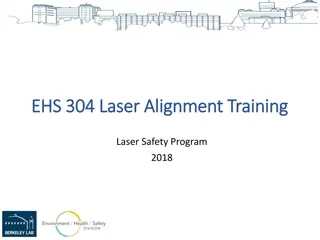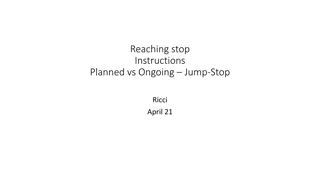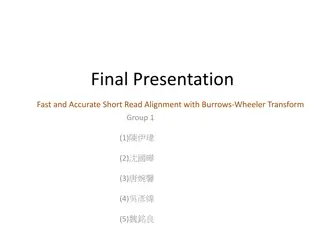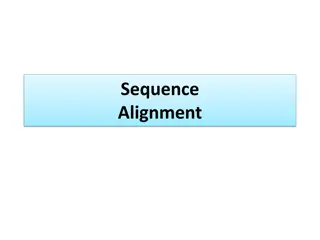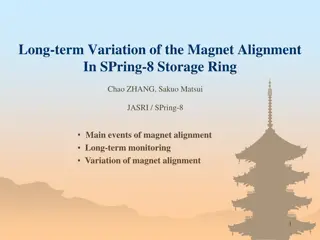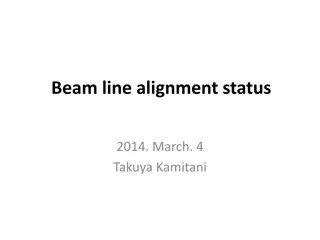Solving Common Alignment Issues in Cavendish Experiment
Learn how to address alignment challenges in the Cavendish experiment through procedures such as centering front-to-back pitch, side-to-side roll, laser, torsion wire, and minimizing spot size. Explore methods to stabilize the table and insights on torsion wire stability. Gain valuable tips from expert comments on handling long-term drifts and sudden shifts in the experiment setup.
Download Presentation

Please find below an Image/Link to download the presentation.
The content on the website is provided AS IS for your information and personal use only. It may not be sold, licensed, or shared on other websites without obtaining consent from the author.If you encounter any issues during the download, it is possible that the publisher has removed the file from their server.
You are allowed to download the files provided on this website for personal or commercial use, subject to the condition that they are used lawfully. All files are the property of their respective owners.
The content on the website is provided AS IS for your information and personal use only. It may not be sold, licensed, or shared on other websites without obtaining consent from the author.
E N D
Presentation Transcript
Centering First, center front-to-back pitch. This can be done by adjusting the front knob. This should be done carefully, as the pivot of the left knob can interfere. Figure 1 Adjust at 2/3 rate of rear knob After front-to-back pitch is centered, center table side- to-side roll. This can be done by adjusting solely the left knob, as the other two pivot points lie along the right edge. (Fig 2) Figure 2
Centering Laser Upon centering laser, noticed that there was a reflection from the window on the board, in addition to the reflection from the mirror. After several trials adjusting the rail, we determined that the window was untrue by 0.0015 radians. As such, there is no need to center the spots from the window when they reflect on the wall, and should be disregarded.
Centering Torsion Wire To center the torsion wire, bring laser up from mirror, then use shadow of torsion wire to center side to side. Then bring laser down and center top-to-bottom.
Minimizing Spot Size Size of laser dot was focused via movement of the focusing lens, not via movement of the laser. This enables a focused dot while preserving the centering of the laser.
Stabilizing the Table Four 25lb. lead weights were added to the table. Previously, shifting of the larger masses caused a skewing of the roll of the table, a result of the anti-shock pads which were placed between the mounting points and the table in order to reduce vertical vibrations. TICO LF/PA/10 Shock Pads
Comments on Torsion Wire Stability From: "David Haase" david_haase@ncsu.edu/ To: "advlabs-l" <advlabs-l@mail.aapt.org> Sent: Thursday, March 24, 2011 9:06 AM Subject: [advlabs-l] Tel-Atomic Cavendish experiment We are using the Tel-Atomic Cavendish experiment with the tungsten support wire and capacitive position sensor. Despite several efforts for vibration isolation we see long term drifts in the equilibrium position and sometimes sudden shifts. Has anyone else experience of this type of behavior? Thanks, David Haase David: The drift and shifts that you see may be due to creeping of the tungsten suspension wire, either at the upper or lower end (or both). At the suspension points, the wire passes through a hole and is looped/knotted around the upper or lower post, not clamped at the suspension point. Without a fixed attachment, the wire can creep incrementally or shift to a new position. I've seen this behavior occasionally, usually after a new wire has been installed, or when the unit is removed from storage (once a year) and the hanging masses are lifted back into position. If the wire doesn't seem to settle in over time, you might try a small drop of plastic cement (Duco or similar), applied very carefully with a toothpick to the point where the wire rests on the suspension post. Make sure the wire is under tension as the cement sets. The dried cement can always be scraped off when the wire (eventually) breaks and needs to be replaced. Other than the awkward suspension, the apparatus works pretty well for us, most of the time. Hope this helps, Mark D. Stephens, Lab Manager, Binghamton Univ. Physics
Error from Oscillatory Motion This happens most frequently as a result of external vibrations, but it sometimes persists despite careful procedure Two modes: Vertical: the dot oscillates vertically at a rate of ~5Hz (estimated) The amplitude of this motion oscillates as well, with a long period Elliptical: the dot oscillates in a loop at a rate of ~1Hz (10 cycles in 9.9 seconds) The period of a simple pendulum is given by ? = 2? ?/? where L is pendulum length and g is the gravitational acceleration constant. There are multiple points in the apparatus that can function as a pivot. One is 30cm above the weights: ? = 2? 0.3/9.8 = 1.1 seconds 1 ?= ? = 1 1.099= 0.91Hz 0.051 9.8 = 0.45 seconds One is 5cm above the weights: ? = 2? 1 ?= ? = 1 0.452= 2.2Hz The 30cm pivot seems to correspond with the elliptical motion. The 5.1cm pivot may be related to the vertical motion, but the frequency given by the equation is lower than expected, so there are most likely other factors involved as well.



